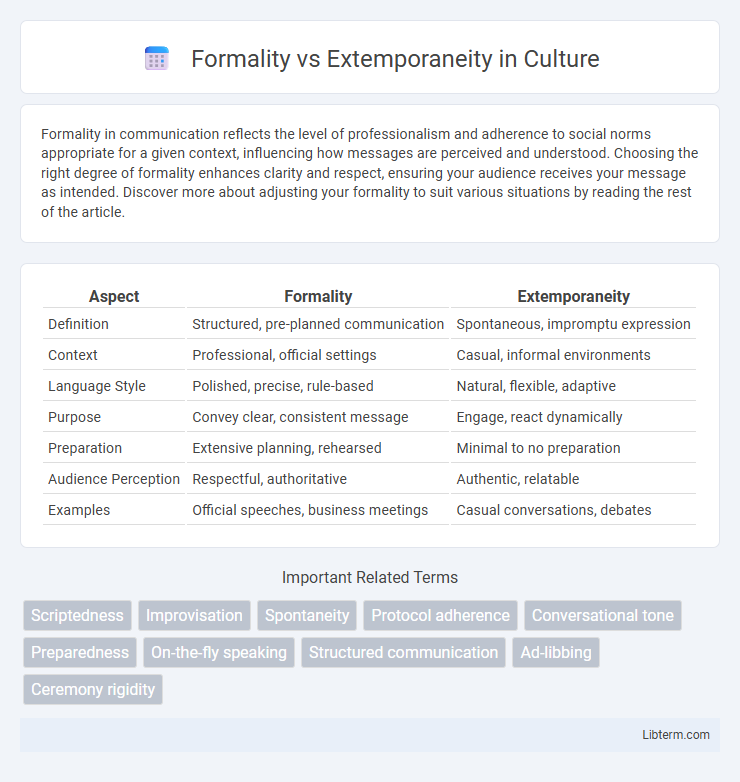Formality in communication reflects the level of professionalism and adherence to social norms appropriate for a given context, influencing how messages are perceived and understood. Choosing the right degree of formality enhances clarity and respect, ensuring your audience receives your message as intended. Discover more about adjusting your formality to suit various situations by reading the rest of the article.
Table of Comparison
| Aspect | Formality | Extemporaneity |
|---|---|---|
| Definition | Structured, pre-planned communication | Spontaneous, impromptu expression |
| Context | Professional, official settings | Casual, informal environments |
| Language Style | Polished, precise, rule-based | Natural, flexible, adaptive |
| Purpose | Convey clear, consistent message | Engage, react dynamically |
| Preparation | Extensive planning, rehearsed | Minimal to no preparation |
| Audience Perception | Respectful, authoritative | Authentic, relatable |
| Examples | Official speeches, business meetings | Casual conversations, debates |
Understanding Formality in Communication
Formality in communication refers to the use of structured language, precise vocabulary, and adherence to conventional rules, often found in professional or official contexts. It emphasizes clarity, respect, and professionalism to ensure messages are interpreted accurately and maintain a sense of authority. Recognizing the appropriate level of formality improves effectiveness in business meetings, academic presentations, and legal negotiations.
Defining Extemporaneity: Key Characteristics
Extemporaneity refers to the ability to speak or perform without detailed preparation, relying on spontaneous expression and quick thinking. Key characteristics include natural fluency, adaptability to audience feedback, and the ability to organize thoughts coherently in real time. This style contrasts with formality by emphasizing conversational tone and authentic interaction over rigid structure.
Historical Context: Formal vs. Extemporaneous Styles
Formal speech styles originated in ancient rhetorical traditions, emphasizing carefully structured and rehearsed delivery rooted in classical education and public oratory. Extemporaneous styles emerged alongside democratic movements and mass media, prioritizing spontaneity and adaptability to engage audiences in real-time contexts. The historical shift reflects evolving communication needs from rigid, scripted presentations to dynamic and interactive exchanges.
Situations Suited for Formal Communication
Formal communication is best suited for professional settings such as business meetings, official presentations, legal proceedings, and academic conferences where precise language and structured delivery are essential. This mode ensures clarity, reduces misunderstandings, and maintains a respectful tone appropriate for hierarchical or unfamiliar audiences. Industries like finance, law, and government often rely on formal communication to uphold standards and document information accurately.
When Extemporaneity Works Best
Extemporaneity works best in dynamic environments requiring quick thinking and adaptability, such as live presentations or impromptu meetings. It enhances audience engagement by allowing speakers to respond naturally to feedback and adjust messaging in real-time. This approach leverages spontaneity to create authentic interactions, increasing connection and impact compared to rigid, formal delivery.
Benefits of Formality in Professional Settings
Formality in professional settings fosters clear communication, reduces misunderstandings, and establishes respect among colleagues. It creates a structured environment that supports accountability and ensures consistency in interactions and decision-making. By adhering to formal protocols, organizations enhance their credibility and strengthen their professional image.
Advantages of Extemporaneous Expression
Extemporaneous expression promotes spontaneity and authentic communication, allowing speakers to adapt their message dynamically based on the audience's reactions and context. This flexibility enhances engagement and encourages natural interactions, which are often more persuasive and relatable than rigid scripted speeches. Moreover, extemporaneous speaking fosters quick thinking and confidence, skills essential for effective public communication and decision-making.
Potential Drawbacks of Each Approach
Formality in communication often leads to rigid structures that can stifle creativity and inhibit spontaneous interactions, resulting in less authentic exchanges. Extemporaneity, while fostering flexibility and dynamic dialogue, risks producing unclear or inconsistent messages due to lack of preparation. Both approaches present challenges in balancing clarity, engagement, and efficiency across professional and social contexts.
Striking the Right Balance: Practical Tips
Striking the right balance between formality and extemporaneity enhances communication effectiveness by adapting tone to context and audience expectations. Use prepared outlines to guide speech while allowing flexibility for spontaneous interaction, ensuring clarity without sacrificing engagement. Practice active listening and adjust language immediacy to maintain professionalism and authenticity in diverse settings.
Future Trends: Evolving Communication Norms
Future communication trends reveal a shift toward balancing formality and extemporaneity as digital platforms foster more spontaneous interactions alongside traditional structured exchanges. Advances in AI-powered writing tools and real-time collaboration software encourage adaptive communication styles, blending formal clarity with informal fluency to suit diverse audiences. Organizations increasingly prioritize hybrid communication models to enhance engagement, reflecting evolving norms that value authentic expression without sacrificing professionalism.
Formality Infographic

 libterm.com
libterm.com